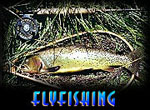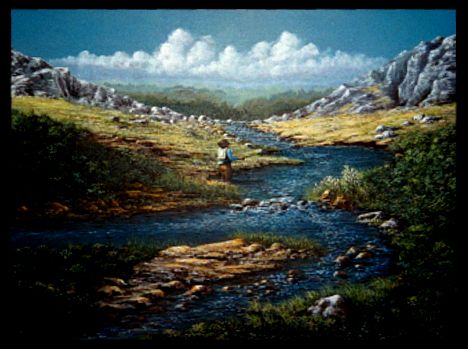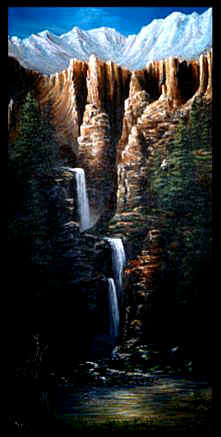|

There's no doubt that experience is the best teacher,
especially when it comes to fly fishing and catching the big ones.
If you're relatively new to the sport, you'll definitely want to
read on for some great tips on casting and fly fishing strategies.
The more you know, the more trout you'll catch and release.
There's another fringe benefit to expanding your knowledge.
It'll make you want to spend more time on your favorite river! |
If
you want to catch more trout, at
some point you'll have to make a commitment to spending a little
time watching what's happening to your fly line while it's in the
air. Casting a fly is not really as difficult as many
experienced fly fishers would have you believe. Actually the
principles are easy to understand and a little practice is all it
will take to perfect your presentation. I've watched many inept
fishermen flogging the water in vain, trying to catch a trout that
had run for cover from splashing line on the very first cast. You
don't need this to happen to you!
Learn the Basics
of a Great Cast
Ten
and Two
 Trout live and thrive in
a world that most of us can only imagine. Fortunately, most fly
fishermen have a basic working knowledge as to where the trout will
be hiding in any given section of water. The only thing that stands
between the fisherman and a successful hook-up is the right cast.
Ten and two refers to the relative movement of your casting hand and
forearm, from ten o'clock to about two o'clock. Start by holding
your rod with a relaxed handshake grip. Pull out ten to twenty feet
of line and start the ten to two motion. Be sure that your rod tip
is moving in a straight line with no upward arc in the middle of
your stroke. The line will follow the rod tip, so if you want a cast
that turns over well and heads straight for the target, keep the rod
tip on a straight line that is higher at the two o'clock position
and lower on the forward stroke. The final ingredient is wrist
action. This is the flick of the wrist that loads the rod tip and
accelerates the line on your back cast and again on the final
delivery to the water. Load the rod with a flick of the wrist to
change the direction and energize the line toward your target. If
the line flows out smoothly and lands on the water just after it
becomes straight, you've made a successful straight line cast. With
practice to improve your timing and coordination, you'll be able to
deliver a smooth, quiet, straight line cast with very little effort.
Trout live and thrive in
a world that most of us can only imagine. Fortunately, most fly
fishermen have a basic working knowledge as to where the trout will
be hiding in any given section of water. The only thing that stands
between the fisherman and a successful hook-up is the right cast.
Ten and two refers to the relative movement of your casting hand and
forearm, from ten o'clock to about two o'clock. Start by holding
your rod with a relaxed handshake grip. Pull out ten to twenty feet
of line and start the ten to two motion. Be sure that your rod tip
is moving in a straight line with no upward arc in the middle of
your stroke. The line will follow the rod tip, so if you want a cast
that turns over well and heads straight for the target, keep the rod
tip on a straight line that is higher at the two o'clock position
and lower on the forward stroke. The final ingredient is wrist
action. This is the flick of the wrist that loads the rod tip and
accelerates the line on your back cast and again on the final
delivery to the water. Load the rod with a flick of the wrist to
change the direction and energize the line toward your target. If
the line flows out smoothly and lands on the water just after it
becomes straight, you've made a successful straight line cast. With
practice to improve your timing and coordination, you'll be able to
deliver a smooth, quiet, straight line cast with very little effort.
Controlling the Line
 About
ten minutes after you rig up your new fly rod and reel and try
casting for the first time, you realize that something must be done
about all this fly line that's laying at your feet. Proper line
handling is a must for the serious fly fisher. It's a skill that's
not difficult to master if you practice every time you cast. Force
yourself to do it and soon it'll become second nature. Here's how.
First, make a simple straight line cast. Then immediately place the
line over the index finger of your rod hand. this is the first step
to proper line control because this line-over-the-finger technique
makes it possible to slide or stop the line with a pinch of the
finger against the rod. Next, grasp the line between the reel and
your pinch finger with your free hand. As the line drifts toward
you, slack line will develop and, you'll need to begin stripping the
line. That's the job of your line hand. Slowly strip in the line
placing each two or three foot coil over your pinch finger. When you
have completed the drift, pick up the fly with a flick of your rod
and begin false casting. Each time you take the rod back get ready
to release a coil or two of line on each following forward stroke.
This is called shooting line and it's a very important skill
that you'll use in just about every fishing situation. On the final
stroke of your second cast, let the remaining coils of line slide
through your pinch finger and "shoot" the line toward your target.
About
ten minutes after you rig up your new fly rod and reel and try
casting for the first time, you realize that something must be done
about all this fly line that's laying at your feet. Proper line
handling is a must for the serious fly fisher. It's a skill that's
not difficult to master if you practice every time you cast. Force
yourself to do it and soon it'll become second nature. Here's how.
First, make a simple straight line cast. Then immediately place the
line over the index finger of your rod hand. this is the first step
to proper line control because this line-over-the-finger technique
makes it possible to slide or stop the line with a pinch of the
finger against the rod. Next, grasp the line between the reel and
your pinch finger with your free hand. As the line drifts toward
you, slack line will develop and, you'll need to begin stripping the
line. That's the job of your line hand. Slowly strip in the line
placing each two or three foot coil over your pinch finger. When you
have completed the drift, pick up the fly with a flick of your rod
and begin false casting. Each time you take the rod back get ready
to release a coil or two of line on each following forward stroke.
This is called shooting line and it's a very important skill
that you'll use in just about every fishing situation. On the final
stroke of your second cast, let the remaining coils of line slide
through your pinch finger and "shoot" the line toward your target.
Mending the Line
If
you've ever watch an experienced fly fisherman working the water,
you have undoubtedly noticed how the rod tip is used to reposition
the line on the water and extend the drag free drift of the fly.
Mending requires an experienced wrist and a good feel for the rod
that you're using. Start by making a straight line cast. As soon as
the line is on the water use a wrist flick and circular motion of
the rod tip to mend the first ten or fifteen feet of line upstream.
The idea is to take any line dragging pressure off the fly and allow
it to float without drag for as long as possible.
Stacking the Bucket
 Do
you enjoy fishing with nymphs? Lots of fly fisherman prefer sinking
their flies for a chance at the big guys. I'll have to admit, a good
nymph fisherman will usually hook more and bigger fish. One of the
first challenges in nymph fishing is developing some method of
getting the fly down near the bottom where the fish are.
Do
you enjoy fishing with nymphs? Lots of fly fisherman prefer sinking
their flies for a chance at the big guys. I'll have to admit, a good
nymph fisherman will usually hook more and bigger fish. One of the
first challenges in nymph fishing is developing some method of
getting the fly down near the bottom where the fish are.
An effective way to accomplish this is to use some form of stacking
the line in order to sink your fly rapidly. Start with an upstream
cast and immediately pull some line off your reel while drawing the
rod tip high and close to you. When you see a "belly" develop in the
line that's above the water, use a small circular wrist-flip and
release the line in hand. Continue re-casting the slack line to the
point where the line is sinking as your fly drifts in front of you.
Try to "stack" coils of line right on top of each other. The effect
of this technique is to keep any and all pressure off your fly,
allowing the fly to sink at the fastest rate possible and to drift
into the window undisturbed.
As with all special casts, practice makes perfect. It's like
shooting coils of line into a bucket, and it will result in getting
your fly down to the fish faster. Once your fly has descended to the
bottom, carefully take up the slack to stay "in touch" with your
fly, and continue your presentation drift through the hole. If you
feel any hesitation of the fly, gently raise your rod tip...you
probably will be rewarded with a trout.
Fly Fishing Strategies That Pay Off
For More Trout - Read The
Water
 Nothing
beats the excitement you feel when you arrive at your favorite
stream. Itís a beautiful, cool morning, and the sun is just breaking
on the water. You can see clouds of tiny black midges hovering just
above the surface, and floating by are more than a few pale morning
duns. As you approach the riverís edge, there is a sudden and
unmistakable slashing rise, then another, and another. Itís tough to
calm yourself enough to get a fly tied on and start fishing. This
could be one of those elusive 40-fish days. You immediately wade
right in and start flailing away, casting rapidly and
indiscriminately everywhere, trying to take advantage of the rising
trout. After a couple dozen casts with no strikes, the surface
activity has virtually stopped. What happened to the fish? Is the
feeding frenzy over already? What did I do wrong?
Nothing
beats the excitement you feel when you arrive at your favorite
stream. Itís a beautiful, cool morning, and the sun is just breaking
on the water. You can see clouds of tiny black midges hovering just
above the surface, and floating by are more than a few pale morning
duns. As you approach the riverís edge, there is a sudden and
unmistakable slashing rise, then another, and another. Itís tough to
calm yourself enough to get a fly tied on and start fishing. This
could be one of those elusive 40-fish days. You immediately wade
right in and start flailing away, casting rapidly and
indiscriminately everywhere, trying to take advantage of the rising
trout. After a couple dozen casts with no strikes, the surface
activity has virtually stopped. What happened to the fish? Is the
feeding frenzy over already? What did I do wrong?
Iíve experienced this same frustrating scenario more than a few
times. If this has happened to you too, maybe itís time to take a
little different approach.
Just being in the right
place at the right time isnít always enough to guarantee that youíll
be successful in taking trout. Reading the water, planning your
attack, and stalking your prey correctly will give you the best
chance of success.
Make it a hard and fast rule never to jump right in before you have
taken at least a few minutes to acclimate yourself to whatís
happening in, on, and around the water youíre going to fish. Walk
quietly to a vantage point a safe distance from the bank, sit down,
and get the feel of the place. First watch for rising fish, and pay
attention to where they are surfacing and how often. Then look at
the current patterns on the surface and determine the likely places
where fish should be holding. These prime places include:
-
1) Seams-areas
where faster water meets slower current. These are natural places
for feeding trout to wait for the conveyor belt of current to
deliver the food. Trout will sit on the slower side and make short
runs into the faster water to grab a fly.
-
-
2) Pockets-fish
the upstream edge of deeper pockets and look for places where
shallow water runs to deep. The best tactic here is to cast
upstream in the shallow current and get a drag-free float into and
over the deeper water. Fish will hide in the deeper pockets
because the current is slower requiring less energy for the fish
to hold.
-
-
3) Behind larger rocks and
boulders-sometimes youíll get a
big surprise drifting your dry fly from slightly upstream and
along the edge of these natural feeding areas. A good pocket-water
and boulder fisherman can expect to have a great day almost every
day, but youíll have to be precise with placement of your cast to
be effective. A high-floating and very visible dry fly is a big
help, because strong currents in this type of water will do there
best to sink your bug.
-
-
4) Deep Pools-a
trickier proposition, but a set-up thatís not to be overlooked.
Take a few minutes to see if you can first determine exactly what
the trout are taking and whether or not the natural insects are on
the surface, near the bottom, or somewhere in between. If you see
big showy rises where trout are coming all the way out of the
water, go with a dry fly thatís the same size and color of the
naturals. In the case of no surface activity, use a few small
lead-free split shot a foot or two up from a wet fly and cast a
bit upstream, letting the fly slowly sink into the pool. Be ready
for a strike when the line comes tight. Slowly strip in the line
as the fly moves toward the surface. A lot of times you can get a
big trout to chase your imitation and a hard strike and hook-up
could result.
-
-
5) Riffles-perhaps
the most enjoyable trout fishing I know. There is a large constant
shallow riffle, and lots of bugs on the water. In this situation,
you may not be able to see feeding fish, but they will probably be
in there. Make an upstream cast, keep the slack out of your line
and watch your fly closely for the strike.
Applying these simple
casting methods and reading the water will definitely increase
your catch rate!
Meet The Author
Follow this link for





 Trout live and thrive in
a world that most of us can only imagine. Fortunately, most fly
fishermen have a basic working knowledge as to where the trout will
be hiding in any given section of water. The only thing that stands
between the fisherman and a successful hook-up is the right cast.
Ten and two refers to the relative movement of your casting hand and
forearm, from ten o'clock to about two o'clock. Start by holding
your rod with a relaxed handshake grip. Pull out ten to twenty feet
of line and start the ten to two motion. Be sure that your rod tip
is moving in a straight line with no upward arc in the middle of
your stroke. The line will follow the rod tip, so if you want a cast
that turns over well and heads straight for the target, keep the rod
tip on a straight line that is higher at the two o'clock position
and lower on the forward stroke. The final ingredient is wrist
action. This is the flick of the wrist that loads the rod tip and
accelerates the line on your back cast and again on the final
delivery to the water. Load the rod with a flick of the wrist to
change the direction and energize the line toward your target. If
the line flows out smoothly and lands on the water just after it
becomes straight, you've made a successful straight line cast. With
practice to improve your timing and coordination, you'll be able to
deliver a smooth, quiet, straight line cast with very little effort.
Trout live and thrive in
a world that most of us can only imagine. Fortunately, most fly
fishermen have a basic working knowledge as to where the trout will
be hiding in any given section of water. The only thing that stands
between the fisherman and a successful hook-up is the right cast.
Ten and two refers to the relative movement of your casting hand and
forearm, from ten o'clock to about two o'clock. Start by holding
your rod with a relaxed handshake grip. Pull out ten to twenty feet
of line and start the ten to two motion. Be sure that your rod tip
is moving in a straight line with no upward arc in the middle of
your stroke. The line will follow the rod tip, so if you want a cast
that turns over well and heads straight for the target, keep the rod
tip on a straight line that is higher at the two o'clock position
and lower on the forward stroke. The final ingredient is wrist
action. This is the flick of the wrist that loads the rod tip and
accelerates the line on your back cast and again on the final
delivery to the water. Load the rod with a flick of the wrist to
change the direction and energize the line toward your target. If
the line flows out smoothly and lands on the water just after it
becomes straight, you've made a successful straight line cast. With
practice to improve your timing and coordination, you'll be able to
deliver a smooth, quiet, straight line cast with very little effort. About
ten minutes after you rig up your new fly rod and reel and try
casting for the first time, you realize that something must be done
about all this fly line that's laying at your feet. Proper line
handling is a must for the serious fly fisher. It's a skill that's
not difficult to master if you practice every time you cast. Force
yourself to do it and soon it'll become second nature. Here's how.
First, make a simple straight line cast. Then immediately place the
line over the index finger of your rod hand. this is the first step
to proper line control because this line-over-the-finger technique
makes it possible to slide or stop the line with a pinch of the
finger against the rod. Next, grasp the line between the reel and
your pinch finger with your free hand. As the line drifts toward
you, slack line will develop and, you'll need to begin stripping the
line. That's the job of your line hand. Slowly strip in the line
placing each two or three foot coil over your pinch finger. When you
have completed the drift, pick up the fly with a flick of your rod
and begin false casting. Each time you take the rod back get ready
to release a coil or two of line on each following forward stroke.
This is called shooting line and it's a very important skill
that you'll use in just about every fishing situation. On the final
stroke of your second cast, let the remaining coils of line slide
through your pinch finger and "shoot" the line toward your target.
About
ten minutes after you rig up your new fly rod and reel and try
casting for the first time, you realize that something must be done
about all this fly line that's laying at your feet. Proper line
handling is a must for the serious fly fisher. It's a skill that's
not difficult to master if you practice every time you cast. Force
yourself to do it and soon it'll become second nature. Here's how.
First, make a simple straight line cast. Then immediately place the
line over the index finger of your rod hand. this is the first step
to proper line control because this line-over-the-finger technique
makes it possible to slide or stop the line with a pinch of the
finger against the rod. Next, grasp the line between the reel and
your pinch finger with your free hand. As the line drifts toward
you, slack line will develop and, you'll need to begin stripping the
line. That's the job of your line hand. Slowly strip in the line
placing each two or three foot coil over your pinch finger. When you
have completed the drift, pick up the fly with a flick of your rod
and begin false casting. Each time you take the rod back get ready
to release a coil or two of line on each following forward stroke.
This is called shooting line and it's a very important skill
that you'll use in just about every fishing situation. On the final
stroke of your second cast, let the remaining coils of line slide
through your pinch finger and "shoot" the line toward your target. Do
you enjoy fishing with nymphs? Lots of fly fisherman prefer sinking
their flies for a chance at the big guys. I'll have to admit, a good
nymph fisherman will usually hook more and bigger fish. One of the
first challenges in nymph fishing is developing some method of
getting the fly down near the bottom where the fish are.
Do
you enjoy fishing with nymphs? Lots of fly fisherman prefer sinking
their flies for a chance at the big guys. I'll have to admit, a good
nymph fisherman will usually hook more and bigger fish. One of the
first challenges in nymph fishing is developing some method of
getting the fly down near the bottom where the fish are. Nothing
beats the excitement you feel when you arrive at your favorite
stream. Itís a beautiful, cool morning, and the sun is just breaking
on the water. You can see clouds of tiny black midges hovering just
above the surface, and floating by are more than a few pale morning
duns. As you approach the riverís edge, there is a sudden and
unmistakable slashing rise, then another, and another. Itís tough to
calm yourself enough to get a fly tied on and start fishing. This
could be one of those elusive 40-fish days. You immediately wade
right in and start flailing away, casting rapidly and
indiscriminately everywhere, trying to take advantage of the rising
trout. After a couple dozen casts with no strikes, the surface
activity has virtually stopped. What happened to the fish? Is the
feeding frenzy over already? What did I do wrong?
Nothing
beats the excitement you feel when you arrive at your favorite
stream. Itís a beautiful, cool morning, and the sun is just breaking
on the water. You can see clouds of tiny black midges hovering just
above the surface, and floating by are more than a few pale morning
duns. As you approach the riverís edge, there is a sudden and
unmistakable slashing rise, then another, and another. Itís tough to
calm yourself enough to get a fly tied on and start fishing. This
could be one of those elusive 40-fish days. You immediately wade
right in and start flailing away, casting rapidly and
indiscriminately everywhere, trying to take advantage of the rising
trout. After a couple dozen casts with no strikes, the surface
activity has virtually stopped. What happened to the fish? Is the
feeding frenzy over already? What did I do wrong?